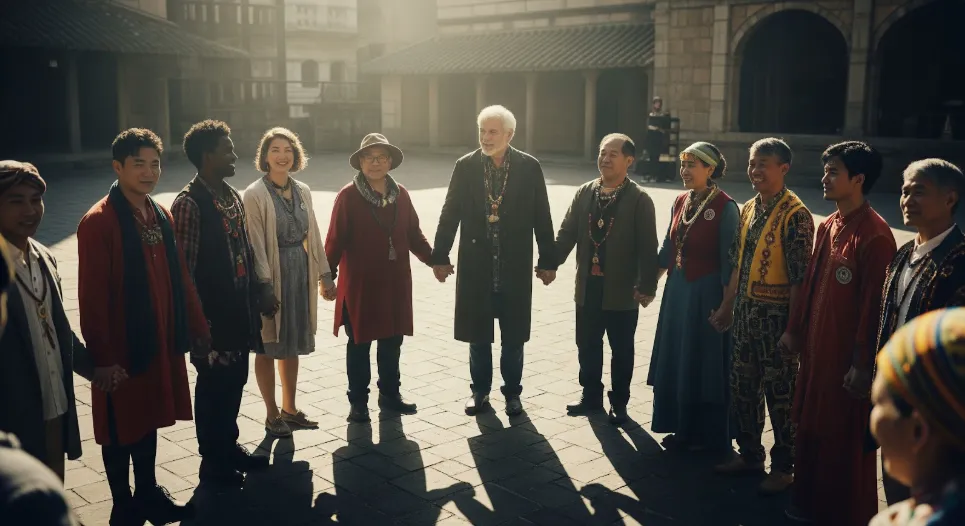
Build a Thriving Cultural Heritage Group Membership with Reliable Revenue
Looking to sustain your heritage organization? With 46% operating on tight budgets, the right membership program can boost donor value by 42%. Lifestyle Fundraiser offers a turnkey solution with travel and entertainment perks members actually use, creating consistent monthly revenue while preserving cultural authenticity.
Key Takeaways:
Nearly half of heritage organizations operate on tight budgets under $100,000 annually, making sustainable revenue critical for cultural preservation
Membership programs with tiered structures can increase donor value by 42% compared to one-time donations
Lifestyle Fundraiser offers heritage groups a turnkey solution to generate monthly revenue through membership perks members actually want
Digital programming has become essential with 92% of cultural organizations now offering virtual experiences
Balancing cultural authenticity with financial sustainability requires strategic revenue diversification
46% of Heritage Groups Operate on Less Than $100,000 Annually
Heritage organizations face a challenging paradox. While they serve as vital custodians of cultural traditions, nearly half operate on annual budgets under $100,000, creating constant financial pressure that threatens their preservation mission. This financial vulnerability is particularly pronounced among organizations affiliated with Black/African American and Hispanic communities.

For these groups, traditional funding follows a familiar but unstable pattern: earned revenue (60%), private contributions (30%), and government funding (10%). However, unlike mainstream nonprofits, cultural heritage organizations often depend more heavily on government support—which can represent 20% or more of their total funding but remains subject to policy shifts and budget cuts.
Sustainable monthly revenue represents the ideal goal for heritage organizations. With consistent income, these groups can shift from survival mode to long-term planning, investing in both preservation activities and growth initiatives that expand their cultural impact. Organizations like Lifestyle Fundraiser have developed fresh approaches to help heritage groups establish dependable revenue streams while honoring their cultural missions.
Membership Programs: The Foundation of Sustainable Revenue
1. Tiered Membership Structure That Works
Successful heritage organizations implement multi-level membership programs that create value at every price point. The Greek Heritage Society of Southern California, for example, offers memberships ranging from $50 to $1,000 annually, with each tier providing increasing access to cultural archives and exclusive events.

Research shows donors who set up recurring donations give 42% more annually than those making one-time contributions. This dramatic difference stems from two factors: the psychological ease of smaller monthly payments versus larger one-time donations, and the ongoing relationship that develops between the organization and regular contributors.
2. Lifestyle Benefits That Drive Retention
Traditional membership benefits like newsletters and event discounts have their place, but today's supporters seek tangible value that enhances their daily lives. Heritage organizations that offer practical lifestyle benefits see dramatically higher retention rates and member satisfaction.
The Chinese American Museum in Los Angeles boosted membership retention by 35% after adding dining discounts at local Asian restaurants to their member benefits. Similarly, a Native American cultural center in Arizona saw membership double after partnering with local businesses to offer authentic craft workshops exclusively for members.
3. How to Price Your Membership Tiers
Effective pricing strikes a balance between accessibility and value. Based on industry benchmarks, successful heritage organizations typically structure their membership tiers as follows:

Basic Membership ($15-25/month): Access to digital content, community events, and basic lifestyle benefits
Cultural Supporter ($50-75/month): Additional access to exclusive workshops, early event registration, and enhanced lifestyle perks
Heritage Patron ($100-150/month): Premium benefits including private events, leadership recognition, and maximum lifestyle advantages
Each tier should offer clear additional value that justifies the price increase, with careful attention to both tangible benefits and emotional rewards like recognition and exclusive access.
4. Setting Up Recurring Payment Systems
Reliable payment processing forms the backbone of any membership program. Modern heritage organizations need systems that can:

Process recurring credit card payments securely
Handle multiple membership tiers efficiently
Automatically manage renewals and payment updates
Provide clear reporting on membership revenue
Even small organizations with limited technical resources can implement these systems. The Polish American Historical Association successfully transitioned from paper-based annual dues to a digital recurring payment system using affordable software, increasing their reliable monthly revenue by 67% while reducing administrative work.
The Lifestyle Fundraiser Model: Membership with Real-World Perks
1. How the Peer Referral System Generates Revenue
The Lifestyle Fundraiser model takes a fundamentally different approach to membership programs. Unlike traditional models where the organization receives membership fees directly, Lifestyle Fundraiser generates revenue through new member sign-ups and an innovative peer referral system.

Here's how it works: When a heritage organization partners with Lifestyle Fundraiser, they receive revenue for each new member who joins through their community. More importantly, they earn ongoing income as those members refer others, creating a continuously expanding network of supporters.
This peer-to-peer approach transforms existing supporters into active advocates. Each time they share membership benefits with friends, family, and colleagues, they expand the organization's reach while simultaneously generating revenue—without requiring additional marketing expenditure from the heritage group.
2. Travel and Entertainment Savings Members Actually Use
The Lifestyle Fundraiser membership offers substantial real-world benefits that supporters value in their daily lives:
Travel discounts on vacations, cruises, and accommodations
Entertainment savings on movies, concerts, sporting events, and theme parks
Dining discounts at thousands of restaurants nationwide
Shopping savings on everyday purchases
These practical benefits maintain high engagement levels because members interact with them regularly. Rather than a membership card that sits unused in a wallet, Lifestyle Fundraiser perks become integrated into members' everyday spending, reinforcing their connection to the heritage organization with each use.
3. Low-Effort Implementation for Small Teams
For heritage organizations with limited staff and resources, Lifestyle Fundraiser's model is particularly valuable because it requires minimal administrative overhead:

No need to create or maintain membership benefits internally
Automated payment processing and renewal management
Built-in marketing tools to promote membership
Ready-to-use communication materials
The platform handles the technical and operational aspects of the membership program, allowing even the smallest heritage organization to implement a sophisticated recurring revenue system without expanding their team or developing technical expertise.
Digital Revenue Opportunities
1. Virtual Cultural Events and Workshops
The pandemic dramatically accelerated digital transformation in the cultural sector, with 92% of heritage organizations now offering some form of digital programming. This shift created new revenue opportunities that extend far beyond geographical limitations.
Virtual events allow heritage organizations to:
Reach global audiences interested in their specific cultural heritage
Scale participation without physical venue constraints
Reduce production costs compared to in-person events
Create tiered pricing for different access levels
The Polish Heritage Association of Maryland pivoted to virtual cooking classes during the pandemic, teaching traditional recipes to participants across North America. Their monthly Polish cooking series now reaches a broader audience than their previous in-person workshops while generating consistent revenue.
2. Online Educational Programs
Educational content represents one of the most valuable assets heritage organizations possess. Cultural knowledge, traditional practices, language instruction, and historical context can all be monetized through structured online programs.

Successful approaches include:
Subscription-based cultural education platforms
On-demand video libraries of traditional practices
Interactive language learning programs
Virtual museum tours and collection access
The Japanese Cultural Center of Hawaii developed a subscription-based digital archive providing access to historical documents, photographs, and oral histories. Their tiered access model supports their mission of preserving and sharing Japanese American history in Hawaii while creating a sustainable revenue stream.

Monetizing Cultural Expertise and Experiences
1. Cultural Consulting Services
Heritage organizations possess specialized cultural knowledge that has significant value to businesses, educational institutions, and government agencies. By packaging this expertise as consulting services, organizations can generate substantial revenue while advancing cultural understanding.
Examples include:
Cultural competency training for corporations
Curriculum development for educational institutions
Cultural authenticity consultation for media productions
Cultural protocol guidance for government agencies
The Latino Cultural Center in Dallas established a consulting division that provides cultural competency training to healthcare providers. Their workshops on Latino cultural practices related to health and wellness improve healthcare outcomes for their community while creating a valuable revenue stream.
2. Heritage Tourism Programs
Heritage tourism represents a multi-billion-dollar market in the United States, with travelers increasingly seeking authentic cultural experiences. Heritage organizations are uniquely positioned to develop tourism programs that showcase their cultural traditions while generating significant revenue.

Successful heritage tourism initiatives include:
Guided cultural tours of significant community sites
Immersive cultural experiences and demonstrations
Culinary tours featuring traditional foods
Festival and celebration packages
The Gullah Heritage Trail Tours in South Carolina offers guided tours highlighting Gullah Geechee culture and history. By showcasing authentic cultural experiences led by community members, they create meaningful connections while establishing a sustainable revenue stream.
3. Traditional Craft Workshops
Traditional crafts and artistic practices represent both cultural heritage and potential revenue streams. Heritage organizations can consider monetizing these skills through:

In-person and virtual craft workshops
Artisan certification programs
Traditional materials and supplies sales
Commission sales of authentic cultural artwork
Many cultural centers have found success with craft workshops that teach traditional techniques—from Indigenous beadwork to Chinese calligraphy—creating both cultural preservation opportunities and revenue.
4. Festival and Event Revenue Optimization
Cultural festivals and events often serve as heritage organizations' most visible activities and potentially their largest revenue generators. Milwaukee's ethnic festivals, for example, generated an estimated $68 million in economic impact, demonstrating the substantial value these cultural celebrations create.

Approaches that might maximize festival revenue include:
Tiered ticket pricing with premium experience options
Corporate sponsorship packages at various investment levels
Vendor booth fees structured as percentage of sales
Merchandise sales featuring festival-specific designs
Many heritage festivals have found success by creating VIP experiences that offer deeper cultural immersion opportunities while generating additional revenue through premium pricing.
5. Authentic Product Sales and Merchandising
Product sales represent a significant revenue opportunity for heritage organizations when those products authentically reflect cultural traditions and provide meaningful connections to heritage.
Cultural merchandise that typically resonates includes:
Traditional craft items made by community artisans
Cultural food products following authentic recipes
Educational materials about cultural traditions
Heritage-inspired contemporary designs
Organizations like the Museum of Chinese in America have developed product lines that thoughtfully blend traditional elements with contemporary design, creating items that appeal to a broad audience while maintaining cultural integrity.
Balancing Cultural Authenticity with Financial Sustainability
Creating sustainable revenue streams while maintaining cultural authenticity presents a delicate balance for heritage organizations. Success often comes from thoughtful consideration of how commercial activities align with cultural values and organizational mission.

Community involvement typically strengthens both cultural authenticity and financial outcomes. Many heritage organizations have found value in:
Consulting cultural elders on product development
Surveying community members about acceptable monetization approaches
Holding transparent discussions about organizational financial needs
Implementing collaborative decision-making on pricing and accessibility
The most sustainable heritage organizations often demonstrate a clear commitment to reinvesting revenue into preservation activities. This creates a virtuous cycle where commercial success directly supports cultural sustainability through:
Funding for cultural documentation and preservation
Scholarship programs for cultural knowledge transmission
Community cultural events with reduced or free access
Acquisition and preservation of cultural artifacts

Tracking both financial and cultural metrics can help ensure balanced organizational development. Effective measurement typically includes both financial indicators (like monthly recurring revenue growth) and cultural impact indicators (such as community engagement levels and intergenerational participation).
For heritage organizations looking to implement sustainable revenue strategies, a phased approach often works best:
Foundation Building (Months 1-3): Establish basic membership systems, identify cultural assets with revenue potential, and build supporter databases
Revenue Diversification (Months 4-8): Launch subscription services, develop partnerships, and create premium cultural experiences
Scaling and Refinement (Months 9-12): Expand digital offerings, optimize existing revenue streams, and build long-term sustainability systems
The journey from financial struggle to sustainability represents a transformation not just in an organization's finances, but in its relationship with supporters and its community impact. By thoughtfully implementing diverse revenue strategies while honoring cultural traditions, heritage organizations can secure both their financial future and their cultural legacy.
Lifestyle Fundraiser helps heritage groups turn cultural pride into sustainable monthly revenue through membership benefits that supporters genuinely value in their everyday lives.
If you need to raise money for your organization. Click here.


